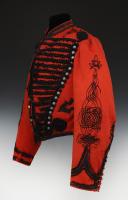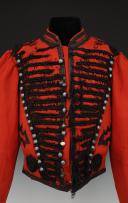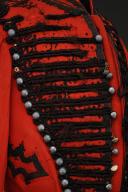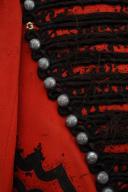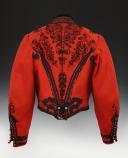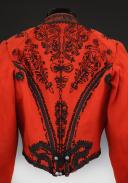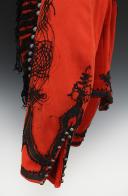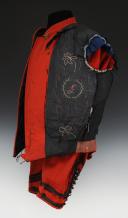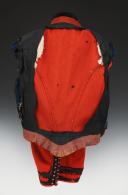
DOLMAN OF THE FRENCH CONTRE-GUERILLA, Mexican Campaign, circa 1862-1865, Second Empire. 29070
Sold out
DOLMAN OF THE FRENCH CONTRE-GUERILLA, Mexican Campaign, circa 1862-1865, Second Empire. 29070
Entirely in madder cloth, closing straight at the front with 18 pewter half-bell buttons stamped with the Coat of Arms of Mexico. The front is trimmed with 18 black goat hair braids trimmed with three buttons each. The seams and false pockets are trimmed with black goat hair braid piped on each side. At the front of the dolman are sewn patterns in large black soutaches wrapping around themselves on each side, top and bottom. Edges of the dolman framed with black braid. Cloth collar of the black braided uniform.
Madder cloth facings edged with a black goat hair braid forming a point. At the level of the facings, back of the sleeve open to a height of 15 cm, with on either side of eight small module silver metal buttons attached using the interior soutache. Each sleeve is trimmed with four black soutaches sewn over the entire height in the shape of a Hungarian knot. Back of the dolman trimmed with two black braids and very richly decorated with soutaches and so-called "butterfly" patterns. Black canvas interior lining. Brown leather interior waist belt.
France.
Mexican campaign, circa 1862-1865, Second Empire.
Bad condition, numerous accidents and losses to the braids, soutaches and braids, part of the lining is missing, missing buttons, holes and moth licks with repairs.
NOTE :
In Mexico, as in the past in Spain, upon the arrival of the French, guerrillas or partisan bands arose in all parts of the territory.
HISTORY:
Mexican Campaign
Du Pin is not a man to feel sorry for himself while France embarks on an expedition to Mexico. Using his connections, he obtained, by ministerial decision of August 15, 1862, to be recalled to activity and seconded to General Almonte, responsible for the organization of the Mexican imperial army; on August 25, he embarked from Cherbourg. Idle due to the general's total disinterest in the organization of the army, Du Pin besieged his comrades who made up the staff of General Forey, commander in chief of the expeditionary force, in Orizaba.
At the same time, the guerrilla war took shape and the expeditionary force had difficulty holding the ground between the coast and the key point of the road to Mexico which represented Puebla; a counter-guerrilla, of private origin and international recruitment, was organized and managed to ensure the external security of the port of Veracruz. However, its military successes were unusable due to a lack of coordination between its leader, the Swiss Charles de Stoëcklin, and the French officers responsible for the region. This situation led General Forey to look for a French officer capable of developing, unifying and coordinating the various existing counter-guerrillas within the framework of the expeditionary force's supply security system.
General Forey was seduced by the personality and efficiency of Colonel Du Pin and entrusted him with command of the counter-guerrilla in the Hot Lands (Tierra caliente), an area between Soledad (es) in the West and Veracruz in the East with a mission to “pursue the bandits of the Hot Lands to the limit and purge the country”. On February 20, 1863, Du Pin returned to his headquarters in Medellin (es) and took command of his troop, a semi-regular unit comprising around a hundred men of eleven different nationalities, equipped and paid by the French army. He completely reorganized it by increasing the force to 650 men, which allowed him to operate with two mixed columns of 250 men each, while ensuring the security of his cantonment.
This new tactical organization allows the counter-guerrilla, initially confined to a role of covering Veracruz facing the South, to take an active part in the security of convoys in the Hot Lands. In March 1863, leaving Medellin with a mixed squadron, Du Pin managed to surprise the Tlaliscoya guerrilla center 80 kilometers from his base, after two days of marching. After the destruction of the Danjou company in Camerone on April 30, 1863, Du Pin garrisoned La Soledad and relieved the foreign regiment in part of its mission. Established in the area most exposed to raids by guerrillas coordinated by Colonel Milán and Colonel Camacho's Jalapa National Guard, it even managed, in June 1863, to temporarily occupy Huatusco, one of the guerrilla bases. On June 28, 1863, his men routed the Mexican troops who had participated in the assault on Camerone and Du Pin was considered by the Legion as the “avenger of Camerone”.
Counter-guerrilla – Vera Cruz Expedition 1864
In December 1863 and despite a few brilliant coups such as the attack on Colonel Ferrerer's convoy, the Mexican guerrillas were forced to abandon the hot lands of Veracruz to allied French or Mexican troops. Crowned with these first successes, Du Pin was appointed, on April 6, 1864, governor of Tampico and the coastal province of Tamaulipas. On April 11, he left the city to confront the brigades of Generals Pavon and Carvajal, which with 1,200 men led the siege of Temapache (es) held by Colonel Llorente and his 300 Mexican allies of France. Although numerically weak, the counter-guerrilla column's arrival pushed Pavon and Carvajal to lift the siege and take refuge in the village of San Antonio. On April 18, Du Pin dislodged the Mexicans with a frontal assault and dispersed the two brigades by force. This success earned him the mention of General Bazaine for his fine attitude in the battle of San Antonio.
With the southern region of Tamaulipas pacified, Du Pin was able to complete the reorganization of his counter-guerrilla movement, which he managed to increase to 1,000 men and more than 500 irregulars. The troops of Juarez, who feared its formidable efficiency, nicknamed the men Los diablos colorados (the colored devils) because of the red color of the dolmans of the riders of the 1st squadron or Los camiceros colorados (the colored butchers).
Two months later, Du Pin mounted a new operation against the guerrillas west and north of Tampico. He crushed the guerrillas of General Casado and Lieutenant-Colonel Perez, as well as the remains of the Pavon brigade under the orders of Colonel Mascarenas during two engagements at Planteadores on July 7, 1864 and at Tantima on July 30. In August, those of the North suffered the same fate so that in four months, he managed to subdue and control a territory of more than 10,000 square kilometers with less than 1,500 men thanks to the lightness of his increasingly columns. more seasoned.
To avoid guarding too many permanent points, Du Pin completed the organization of his unit by recruiting, or organizing, Mexican units placed under his command, on the fringes of his own counter-guerrilla, to which he entrusts the guard of its successive garrisons and of which it takes the best elements in certain operations. Thus in Tampico in May 1864, he entrusted Mexican Colonel Prieto with a local counter-guerrilla force of two squadrons and two companies of 123 men each.
To the great dismay of the generals, he only depends on the commander-in-chief who gave him carte blanche. Considering himself free to act, he reestablished economic circuits and controlled the commercial route of the central part of Tamaulipas, which considerably hampered the illicit business of certain Bordeaux companies, such as deliveries of gunpowder and gun capsules. A first campaign in the French press, conducted from the summer of 1864 at the instigation of trading companies relaying accusations already made by the Mexican press, calls into question his action. Locally in control of the field, never inspected by any authority during his entire time in command at Tampico, Du Pin indulged his natural inclination for autonomy, which attracted jealousies in the French expeditionary force.
French counter-guerrillas - Mexico 1865-1867
He employs in his troop as auxiliaries numerous Indians responsible for “cleaning” and the abuses of his squadron provoke the indignation of both the Mexicans and the French. Some of his men were buried alive, with only their heads protruding, the Mexicans charging their cavalry at them. His band of bandit soldiers who are completely devoted to him and himself with his big beard, his bright and bizarre Mexican-Hungarian uniform and his pistol in his belt, are soon known to the entire army, and his infernal columns, feared liberals. On the territories he controls, he signs the “Governor Charles Du Pin” decrees.
His methods are expeditious. He multiplies the raids, executes prisoners, burns villages suspected of collusion with the Juarists, eliminates suspected civilians. He gives no quarter and acts of cruelty do not put him off. A price of 100,000 francs is put on his head, in vain. At the same time, he wrote tender letters to his niece who would have wanted to marry him if only her parents had consented, and he himself said “I fought an atrocious war”. Implicated by the Emperor Maximilian, and by his peers, the "monster of the Hot Lands", the "red devil", the "hyena of Tamaulipas" or even "the tiger of the tropics", was sent back to France in April 1865, and replaced for a time by Captain Ney d'Elchingen. He has been Commander of the Legion of Honor since December 26, 1864.
An investigation cleared him of the accusations of embezzlement brought against him and he returned to Mexico in January 1866. General Bazaine this time refused to give in to Maximilien, furious at his return, and declared to the person concerned "I would be only too happy to 'have many officers of your caliber'. But the conflict between the emperor of Mexico and the colonel caused a lot of noise, and highlighted the difficult conditions and the questionable means of the intervention. Du Pin ended up being replaced, definitively this time, at the head of the counter-guerrilla by De Galliffet who did not change his method.
Placed on leave on March 25, 1867, he was appointed as a reward, on the following August 16, chief of staff of the cavalry division of the 4th corps, then, on August 27, chief of staff of the 10th division. military, in Montpellier (Hérault). Worn out by his campaigns and excesses of all kinds, he died before his fifty-fourth birthday, single and destitute, of meningitis on October 3, 1868 at the Hôtel-Dieu Saint-Éloi in the city.
General Du Barail, in My Memories, compares him to a “condotiere”, that is to say a leader of mercenary troops. Writer, photographer, scholar, socialite and warrior, a tumultuous private life prevented him from reaching the highest military positions.
Entirely in madder cloth, closing straight at the front with 18 pewter half-bell buttons stamped with the Coat of Arms of Mexico. The front is trimmed with 18 black goat hair braids trimmed with three buttons each. The seams and false pockets are trimmed with black goat hair braid piped on each side. At the front of the dolman are sewn patterns in large black soutaches wrapping around themselves on each side, top and bottom. Edges of the dolman framed with black braid. Cloth collar of the black braided uniform.
Madder cloth facings edged with a black goat hair braid forming a point. At the level of the facings, back of the sleeve open to a height of 15 cm, with on either side of eight small module silver metal buttons attached using the interior soutache. Each sleeve is trimmed with four black soutaches sewn over the entire height in the shape of a Hungarian knot. Back of the dolman trimmed with two black braids and very richly decorated with soutaches and so-called "butterfly" patterns. Black canvas interior lining. Brown leather interior waist belt.
France.
Mexican campaign, circa 1862-1865, Second Empire.
Bad condition, numerous accidents and losses to the braids, soutaches and braids, part of the lining is missing, missing buttons, holes and moth licks with repairs.
NOTE :
In Mexico, as in the past in Spain, upon the arrival of the French, guerrillas or partisan bands arose in all parts of the territory.
HISTORY:
Mexican Campaign
Du Pin is not a man to feel sorry for himself while France embarks on an expedition to Mexico. Using his connections, he obtained, by ministerial decision of August 15, 1862, to be recalled to activity and seconded to General Almonte, responsible for the organization of the Mexican imperial army; on August 25, he embarked from Cherbourg. Idle due to the general's total disinterest in the organization of the army, Du Pin besieged his comrades who made up the staff of General Forey, commander in chief of the expeditionary force, in Orizaba.
At the same time, the guerrilla war took shape and the expeditionary force had difficulty holding the ground between the coast and the key point of the road to Mexico which represented Puebla; a counter-guerrilla, of private origin and international recruitment, was organized and managed to ensure the external security of the port of Veracruz. However, its military successes were unusable due to a lack of coordination between its leader, the Swiss Charles de Stoëcklin, and the French officers responsible for the region. This situation led General Forey to look for a French officer capable of developing, unifying and coordinating the various existing counter-guerrillas within the framework of the expeditionary force's supply security system.
General Forey was seduced by the personality and efficiency of Colonel Du Pin and entrusted him with command of the counter-guerrilla in the Hot Lands (Tierra caliente), an area between Soledad (es) in the West and Veracruz in the East with a mission to “pursue the bandits of the Hot Lands to the limit and purge the country”. On February 20, 1863, Du Pin returned to his headquarters in Medellin (es) and took command of his troop, a semi-regular unit comprising around a hundred men of eleven different nationalities, equipped and paid by the French army. He completely reorganized it by increasing the force to 650 men, which allowed him to operate with two mixed columns of 250 men each, while ensuring the security of his cantonment.
This new tactical organization allows the counter-guerrilla, initially confined to a role of covering Veracruz facing the South, to take an active part in the security of convoys in the Hot Lands. In March 1863, leaving Medellin with a mixed squadron, Du Pin managed to surprise the Tlaliscoya guerrilla center 80 kilometers from his base, after two days of marching. After the destruction of the Danjou company in Camerone on April 30, 1863, Du Pin garrisoned La Soledad and relieved the foreign regiment in part of its mission. Established in the area most exposed to raids by guerrillas coordinated by Colonel Milán and Colonel Camacho's Jalapa National Guard, it even managed, in June 1863, to temporarily occupy Huatusco, one of the guerrilla bases. On June 28, 1863, his men routed the Mexican troops who had participated in the assault on Camerone and Du Pin was considered by the Legion as the “avenger of Camerone”.
Counter-guerrilla – Vera Cruz Expedition 1864
In December 1863 and despite a few brilliant coups such as the attack on Colonel Ferrerer's convoy, the Mexican guerrillas were forced to abandon the hot lands of Veracruz to allied French or Mexican troops. Crowned with these first successes, Du Pin was appointed, on April 6, 1864, governor of Tampico and the coastal province of Tamaulipas. On April 11, he left the city to confront the brigades of Generals Pavon and Carvajal, which with 1,200 men led the siege of Temapache (es) held by Colonel Llorente and his 300 Mexican allies of France. Although numerically weak, the counter-guerrilla column's arrival pushed Pavon and Carvajal to lift the siege and take refuge in the village of San Antonio. On April 18, Du Pin dislodged the Mexicans with a frontal assault and dispersed the two brigades by force. This success earned him the mention of General Bazaine for his fine attitude in the battle of San Antonio.
With the southern region of Tamaulipas pacified, Du Pin was able to complete the reorganization of his counter-guerrilla movement, which he managed to increase to 1,000 men and more than 500 irregulars. The troops of Juarez, who feared its formidable efficiency, nicknamed the men Los diablos colorados (the colored devils) because of the red color of the dolmans of the riders of the 1st squadron or Los camiceros colorados (the colored butchers).
Two months later, Du Pin mounted a new operation against the guerrillas west and north of Tampico. He crushed the guerrillas of General Casado and Lieutenant-Colonel Perez, as well as the remains of the Pavon brigade under the orders of Colonel Mascarenas during two engagements at Planteadores on July 7, 1864 and at Tantima on July 30. In August, those of the North suffered the same fate so that in four months, he managed to subdue and control a territory of more than 10,000 square kilometers with less than 1,500 men thanks to the lightness of his increasingly columns. more seasoned.
To avoid guarding too many permanent points, Du Pin completed the organization of his unit by recruiting, or organizing, Mexican units placed under his command, on the fringes of his own counter-guerrilla, to which he entrusts the guard of its successive garrisons and of which it takes the best elements in certain operations. Thus in Tampico in May 1864, he entrusted Mexican Colonel Prieto with a local counter-guerrilla force of two squadrons and two companies of 123 men each.
To the great dismay of the generals, he only depends on the commander-in-chief who gave him carte blanche. Considering himself free to act, he reestablished economic circuits and controlled the commercial route of the central part of Tamaulipas, which considerably hampered the illicit business of certain Bordeaux companies, such as deliveries of gunpowder and gun capsules. A first campaign in the French press, conducted from the summer of 1864 at the instigation of trading companies relaying accusations already made by the Mexican press, calls into question his action. Locally in control of the field, never inspected by any authority during his entire time in command at Tampico, Du Pin indulged his natural inclination for autonomy, which attracted jealousies in the French expeditionary force.
French counter-guerrillas - Mexico 1865-1867
He employs in his troop as auxiliaries numerous Indians responsible for “cleaning” and the abuses of his squadron provoke the indignation of both the Mexicans and the French. Some of his men were buried alive, with only their heads protruding, the Mexicans charging their cavalry at them. His band of bandit soldiers who are completely devoted to him and himself with his big beard, his bright and bizarre Mexican-Hungarian uniform and his pistol in his belt, are soon known to the entire army, and his infernal columns, feared liberals. On the territories he controls, he signs the “Governor Charles Du Pin” decrees.
His methods are expeditious. He multiplies the raids, executes prisoners, burns villages suspected of collusion with the Juarists, eliminates suspected civilians. He gives no quarter and acts of cruelty do not put him off. A price of 100,000 francs is put on his head, in vain. At the same time, he wrote tender letters to his niece who would have wanted to marry him if only her parents had consented, and he himself said “I fought an atrocious war”. Implicated by the Emperor Maximilian, and by his peers, the "monster of the Hot Lands", the "red devil", the "hyena of Tamaulipas" or even "the tiger of the tropics", was sent back to France in April 1865, and replaced for a time by Captain Ney d'Elchingen. He has been Commander of the Legion of Honor since December 26, 1864.
An investigation cleared him of the accusations of embezzlement brought against him and he returned to Mexico in January 1866. General Bazaine this time refused to give in to Maximilien, furious at his return, and declared to the person concerned "I would be only too happy to 'have many officers of your caliber'. But the conflict between the emperor of Mexico and the colonel caused a lot of noise, and highlighted the difficult conditions and the questionable means of the intervention. Du Pin ended up being replaced, definitively this time, at the head of the counter-guerrilla by De Galliffet who did not change his method.
Placed on leave on March 25, 1867, he was appointed as a reward, on the following August 16, chief of staff of the cavalry division of the 4th corps, then, on August 27, chief of staff of the 10th division. military, in Montpellier (Hérault). Worn out by his campaigns and excesses of all kinds, he died before his fifty-fourth birthday, single and destitute, of meningitis on October 3, 1868 at the Hôtel-Dieu Saint-Éloi in the city.
General Du Barail, in My Memories, compares him to a “condotiere”, that is to say a leader of mercenary troops. Writer, photographer, scholar, socialite and warrior, a tumultuous private life prevented him from reaching the highest military positions.
Reference :
29070
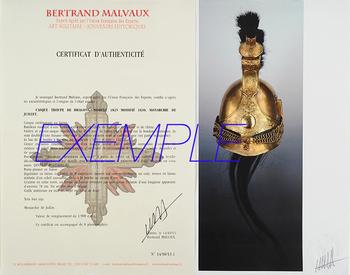
Next update Friday, december 5 at 13:30 PM
FOR ALL PURCHASES, PAYMENT IN MULTIPLE CHECKS POSSIBLE
bertrand.malvaux@wanadoo.fr 06 07 75 74 63
SHIPPING COSTS
Shipping costs are calculated only once per order for one or more items, all shipments are sent via registered mail, as this is the only way to have proof of dispatch and receipt.
For parcels whose value cannot be insured by the Post, shipments are entrusted to DHL or Fedex with real value insured, the service is of high quality but the cost is higher.
RETURN POLICY
Items can be returned within 8 days of receipt. They must be returned by registered mail at the sender's expense, in their original packaging, and in their original condition.
AUTHENTICITY
The selection of items offered on this site allows me to guarantee the authenticity of each piece described here, all items offered are guaranteed to be period and authentic, unless otherwise noted or restricted in the description.
An authenticity certificate of the item including the description published on the site, the period, the sale price, accompanied by one or more color photographs is automatically provided for any item priced over 130 euros. Below this price, each certificate is charged 5 euros.
Only items sold by me are subject to an authenticity certificate, I do not provide any expert reports for items sold by third parties (colleagues or collectors).
FOR ALL PURCHASES, PAYMENT IN MULTIPLE CHECKS POSSIBLE
bertrand.malvaux@wanadoo.fr 06 07 75 74 63
An authenticity certificate of the item including the description published on the site, the period, the sale price, accompanied by one or more color photographs is automatically provided for any item priced over 130 euros. Below this price, each certificate is charged 5 euros.
Only items sold by me are subject to an authenticity certificate, I do not provide any expert reports for items sold by third parties (colleagues or collectors).
